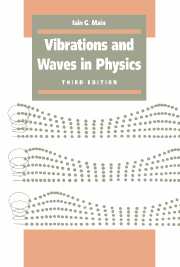Book contents
- Frontmatter
- Contents
- Preface to the first edition
- Preface to the second edition
- Preface to the third edition
- Notes for reference
- 1 Free vibrations
- 2 Free vibrations in physics
- 3 Damping
- 4 Damping in physics
- 5 Forced vibrations
- 6 Forced vibrations in physics
- 7 Anharmonic vibrations
- 8 Two-coordinate vibrations
- 9 Non-dispersive waves
- 10 Non-dispersive waves in physics
- 11 Fourier theory
- 12 Dispersion
- 13 Water waves
- 14 Electromagnetic waves
- 15 De Broglie waves
- 16 Solitary waves
- 17 Plane waves at boundaries
- 18 Diffraction
- Answers to problems and hints for solution
- Constants and units
- Index
12 - Dispersion
Published online by Cambridge University Press: 05 June 2012
- Frontmatter
- Contents
- Preface to the first edition
- Preface to the second edition
- Preface to the third edition
- Notes for reference
- 1 Free vibrations
- 2 Free vibrations in physics
- 3 Damping
- 4 Damping in physics
- 5 Forced vibrations
- 6 Forced vibrations in physics
- 7 Anharmonic vibrations
- 8 Two-coordinate vibrations
- 9 Non-dispersive waves
- 10 Non-dispersive waves in physics
- 11 Fourier theory
- 12 Dispersion
- 13 Water waves
- 14 Electromagnetic waves
- 15 De Broglie waves
- 16 Solitary waves
- 17 Plane waves at boundaries
- 18 Diffraction
- Answers to problems and hints for solution
- Constants and units
- Index
Summary
The wave equation we discussed in chapter 9 has the special property that it allows a disturbance of arbitrary form to be propagated indefinitely as a travelling wave, without having its shape changed. We met several examples of such non-dispersive waves in chapter 10.
Non-dispersive waves are exceptional. In this chapter we examine possible sources of dispersion in a stretched string.
Stiff strings
The stretched string of chapter 9 was assumed to be perfectly flexible, so that there were no transverse return forces other than those due to the tension. Real strings, such as violin and piano strings, are ‘stiff’ and tend to straighten out even when unstretched. The extra return forces due to this lateral stiffness make the string dispersive.
These return forces come from the stresses within curved parts of the string. The stress forces at any cross-section of the string will have components acting along the string direction, and components acting in the plane perpendicular to the string. Each set of components can be replaced by a single force and a single torque: for the components parallel to the string we have the force of tension, and a bending moment, while the perpendicular components give a shear force tending to break the string across, and a twisting moment. Since we already know the return force due to the tension, and since the string is presumably not twisted, we need consider only the other two.
- Type
- Chapter
- Information
- Vibrations and Waves in Physics , pp. 213 - 235Publisher: Cambridge University PressPrint publication year: 1993



